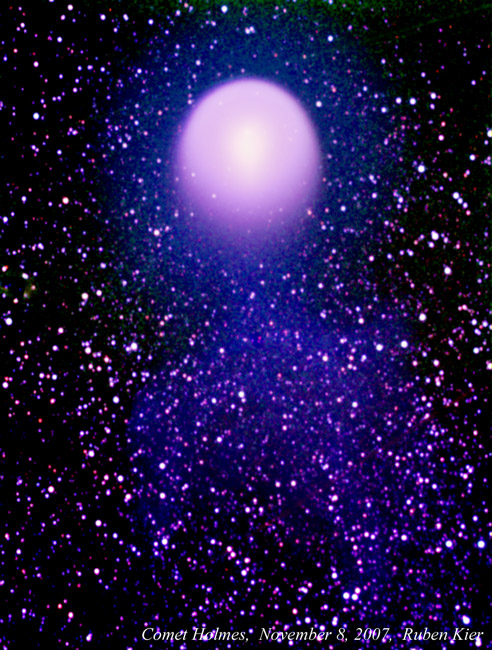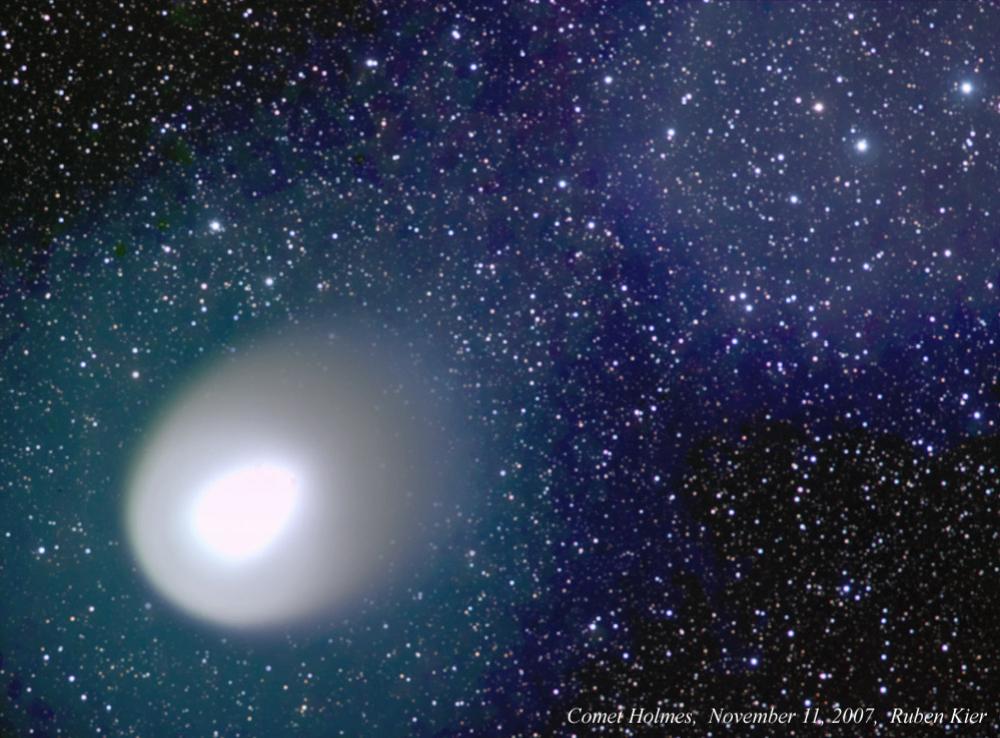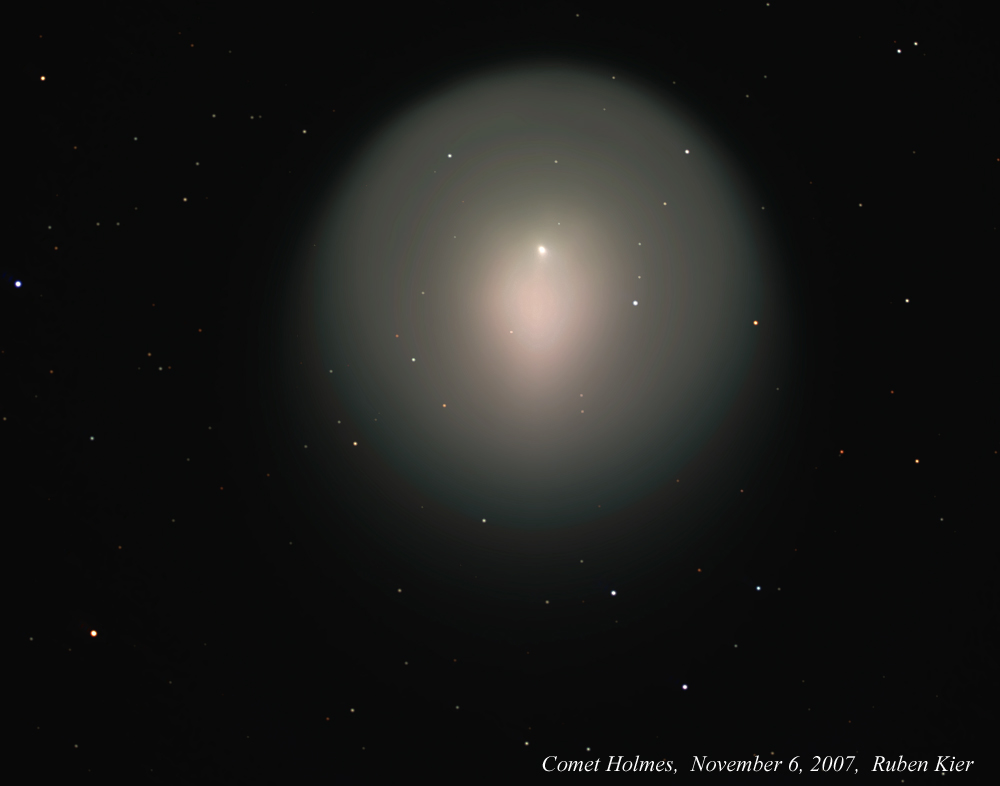| Comet Holmes 2007 |
Comet 17P/Holmes was initially discovered 115 years before my image was
obtained, on November 6, 1892. Unlike the long period comets like Haley's
Comet, Comet Holmes returns every 7 years. Its orbit stays within the solar
system, and for the past hundred years has been only a footnote in the astronomy
books, identified as a dim comet seen only with large telescopes.
Three weeks ago, Comet Holmes underwent an unexpected spectacular outburst
that some have misnamed an "exploding comet." This outburst beginning October
24 initially vauilted brightness from 14th magnitude (about as brignt as Pluto!) to
about 7th magnitude (almost visible with the naked eye). Most astronomers
predicted that the gas ejected during this outburst would gradually disperse and
fade. Surprisingly, the comet has grown even brighter almost every day. On the
night of these photos, the comet was a bright 2nd magnitude in the constellation
Perseus, clearly visible with the naked eye as a fuzzy star. In binoculars or small
telescopes, it seems to explode into a bright hazy ball, half the size of the full
moon! You've gotta see it for yourself,.as the comet coasts about 100 million
miles from Earth, beyond the orbit of Mars. The tail of the comet is barely visible,
because it is so faint compared to the rest of the comet, and hidden by the glow
around the core. You can see a faint tail in the overexposed images on the right
and below. .
The image above combined 27 2-minute Luminance exposures with 9 2-minute
exposures each with red, green and blue filters, for a total imaging time of almost 2
hours. An ST2000XM camera was used through a TEC 140 refractor at the
Hidden Lake Observatory Because the comet is moving slowly against the
background sky, I had to process the star image separately from the comet image,
and then merge the two.
The image on the right was overexposed to show the faint blue ion tail. I used the
same ST2000XM camera through a Takahashi Sky90 refractor with a reducer, to
give less magnification with a wider field of view. I over exposed the core with
10-minute sub-exposures, binned 3x3, including 4 blue and one each red and
green, for a total imaging time of one hour.
The image below was taken with the same setup, but 10-minute subexposures
binned 2x2, including 9 blue and green and 5 red, for a total imaging time of
almost 4 hours.
obtained, on November 6, 1892. Unlike the long period comets like Haley's
Comet, Comet Holmes returns every 7 years. Its orbit stays within the solar
system, and for the past hundred years has been only a footnote in the astronomy
books, identified as a dim comet seen only with large telescopes.
Three weeks ago, Comet Holmes underwent an unexpected spectacular outburst
that some have misnamed an "exploding comet." This outburst beginning October
24 initially vauilted brightness from 14th magnitude (about as brignt as Pluto!) to
about 7th magnitude (almost visible with the naked eye). Most astronomers
predicted that the gas ejected during this outburst would gradually disperse and
fade. Surprisingly, the comet has grown even brighter almost every day. On the
night of these photos, the comet was a bright 2nd magnitude in the constellation
Perseus, clearly visible with the naked eye as a fuzzy star. In binoculars or small
telescopes, it seems to explode into a bright hazy ball, half the size of the full
moon! You've gotta see it for yourself,.as the comet coasts about 100 million
miles from Earth, beyond the orbit of Mars. The tail of the comet is barely visible,
because it is so faint compared to the rest of the comet, and hidden by the glow
around the core. You can see a faint tail in the overexposed images on the right
and below. .
The image above combined 27 2-minute Luminance exposures with 9 2-minute
exposures each with red, green and blue filters, for a total imaging time of almost 2
hours. An ST2000XM camera was used through a TEC 140 refractor at the
Hidden Lake Observatory Because the comet is moving slowly against the
background sky, I had to process the star image separately from the comet image,
and then merge the two.
The image on the right was overexposed to show the faint blue ion tail. I used the
same ST2000XM camera through a Takahashi Sky90 refractor with a reducer, to
give less magnification with a wider field of view. I over exposed the core with
10-minute sub-exposures, binned 3x3, including 4 blue and one each red and
green, for a total imaging time of one hour.
The image below was taken with the same setup, but 10-minute subexposures
binned 2x2, including 9 blue and green and 5 red, for a total imaging time of
almost 4 hours.
Music: Dust in the Wind, by Kansas


